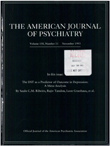Origins of DSM-I: a study in appearance and reality
Abstract
The author traces the history of psychiatric nosology in the United States from its origins in the early nineteenth century to the introduction of DSM-I in 1952. Until World War I, psychiatrists were not interested in systematic classification, although they were concerned with diagnosis. The first official nosology, adopted in 1918, reflected the need to collect mental hospital data. The federal Bureau of the Census had a role in the development of this nosology in that it required such data. The publication of DSM-I marked an internal transformation that mirrored the growing dominance of psychodynamic and psychoanalytic psychiatry and the relative weakness of the biological tradition. This transformation occurred largely as a result of the lessons learned by psychiatrists during World War II. The author's basic argument is that nosology reflected not only psychiatric ideology but also other, external determinants at any given point in time.
Access content
To read the fulltext, please use one of the options below to sign in or purchase access.- Personal login
- Institutional Login
- Sign in via OpenAthens
- Register for access
-
Please login/register if you wish to pair your device and check access availability.
Not a subscriber?
PsychiatryOnline subscription options offer access to the DSM-5 library, books, journals, CME, and patient resources. This all-in-one virtual library provides psychiatrists and mental health professionals with key resources for diagnosis, treatment, research, and professional development.
Need more help? PsychiatryOnline Customer Service may be reached by emailing [email protected] or by calling 800-368-5777 (in the U.S.) or 703-907-7322 (outside the U.S.).



